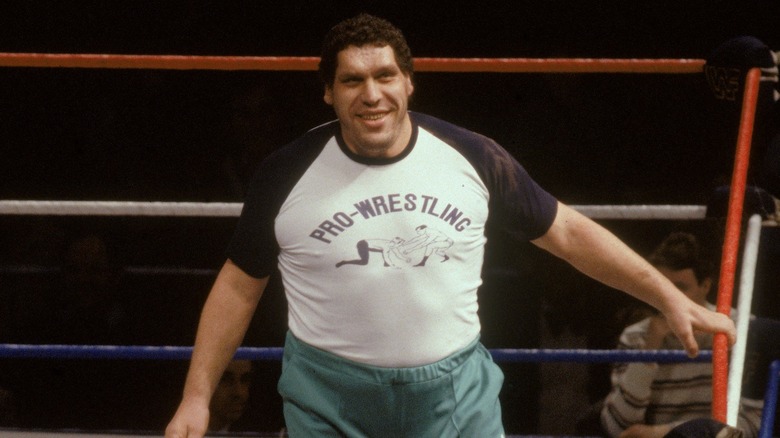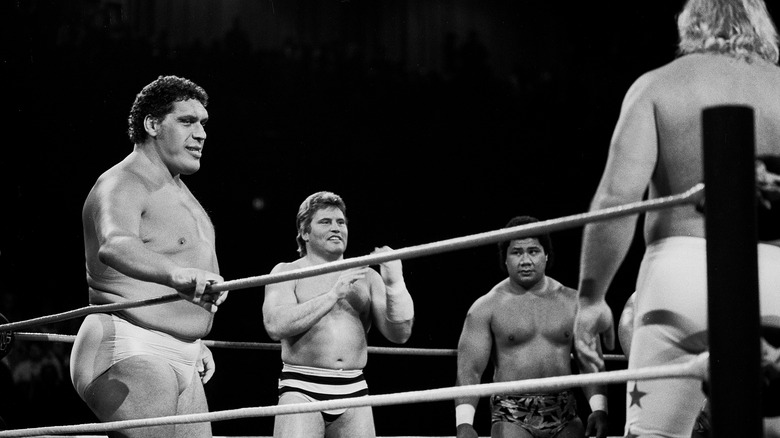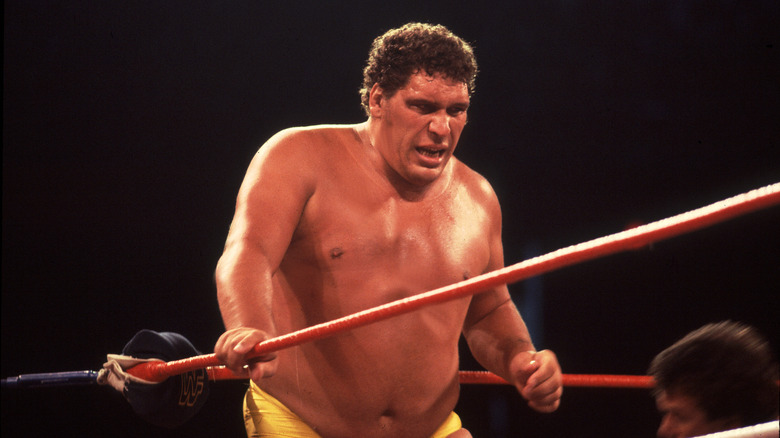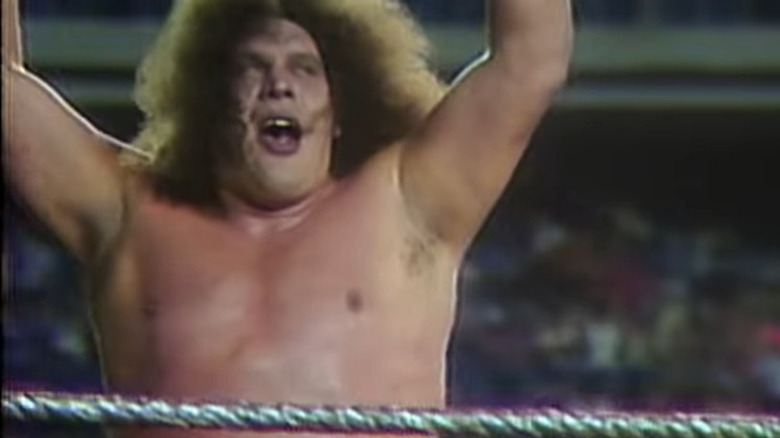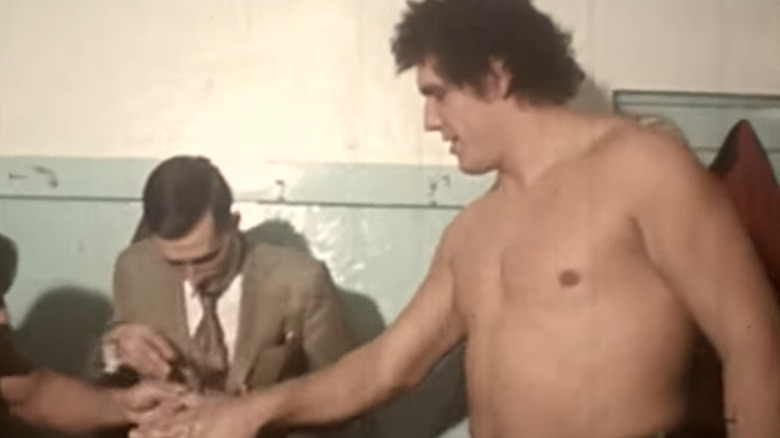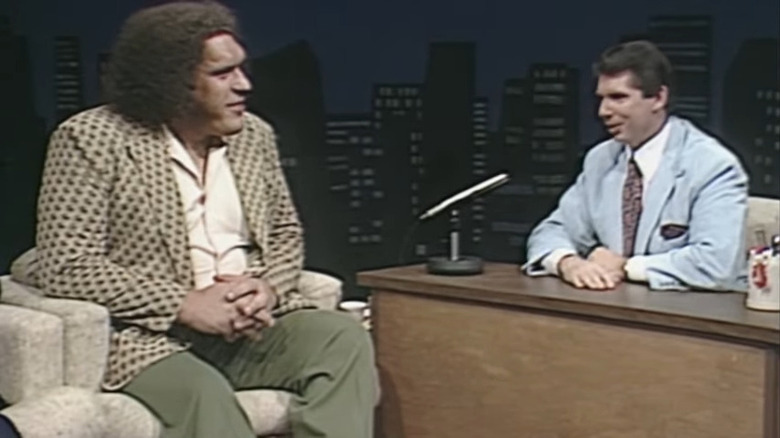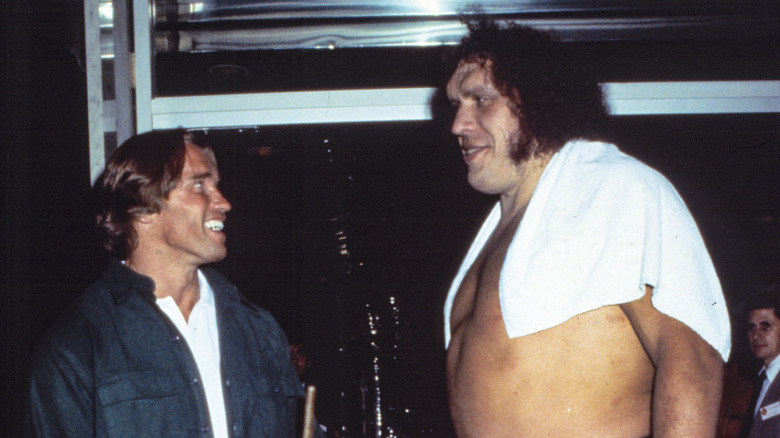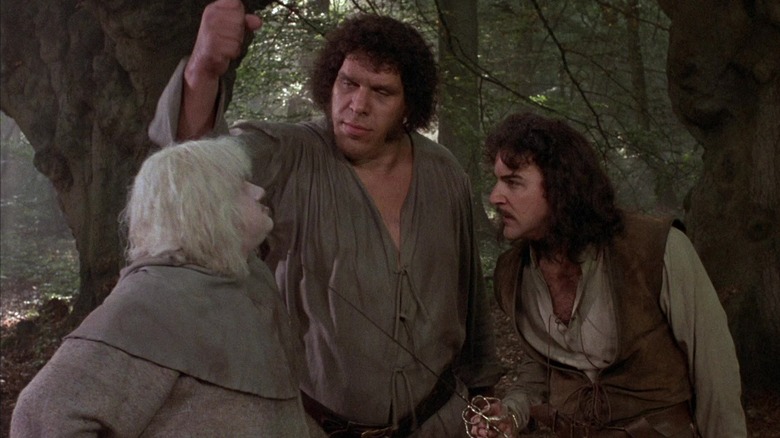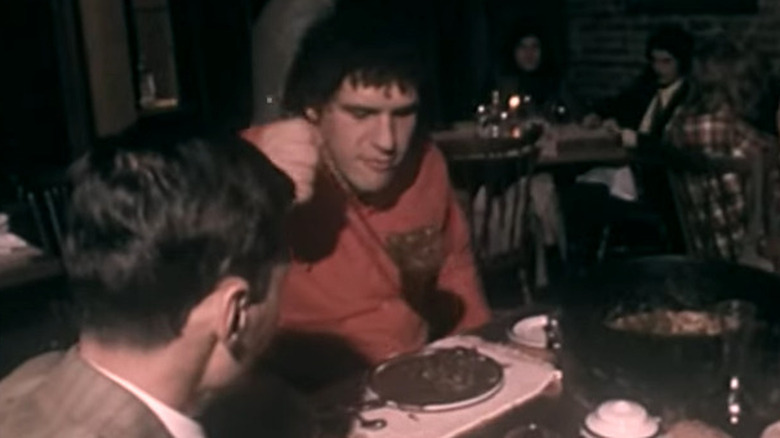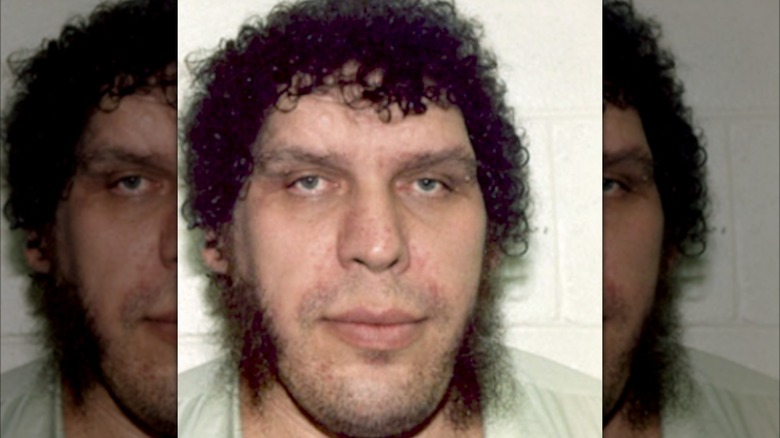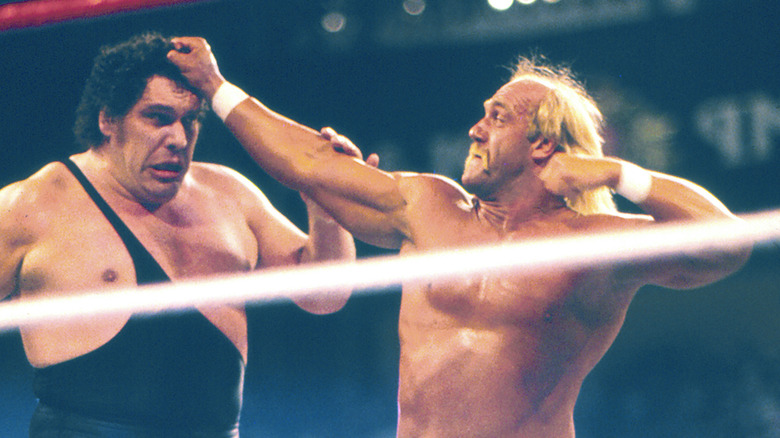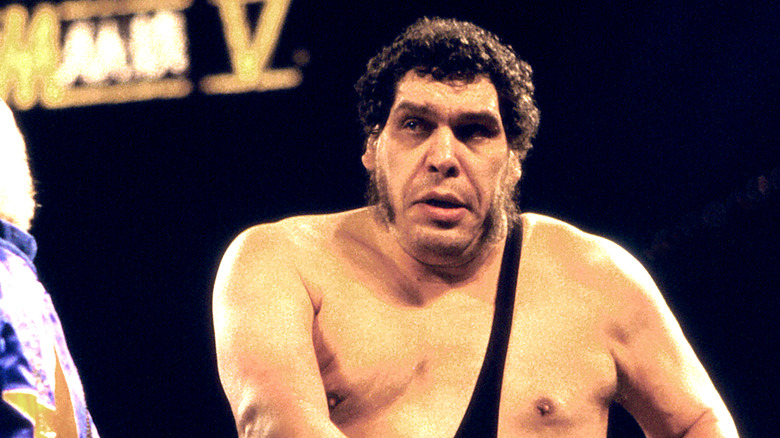The Tragic Life And Death Of Andre The Giant
We may receive a commission on purchases made from links.
Fewer people are more instantly recognizable than the legendary André the Giant. He was a living leviathan among men who helped transform professional wrestling with his larger-than-life physicality and commanding demeanor. Like Muhammad Ali or Mike Tyson, even those who aren't fans of the sport behind André's career know who he was — his legacy transcended wrestling and cemented him as a sort of pop-culture fixation. As a result, André has been the subject of everything from street art to tee shirts and documentaries. His mass inspired fear, awe, and curiosity everywhere he went, along with mythical stories that defy belief.
Even basic facts about André have been muddled, thanks to a combination of pre-internet era documentation, lack of verification from primary sources like family members, and André himself. He understood the power of a good story, and like all wrestlers in his day, reinforced his image through the use of embellishment and shock value. As a result, it can be challenging to sort the truth from rumor and innuendo — which the pro wrestling industry seems to thrive on, and only spurs the stories on even further. The publication of a biography about André, The Eighth Wonder of the World, has brought to light fresh facts from family members and other previously unheard sources. Considering even the most diehard wrestling fans didn't know this information before, this prompts a fresh examination of the fascinating, inspiring, and tragic life and death of André the Giant.
The legend is born
From the moment of birth, André René Roussimoff was notable for his size. He weighed over 13 pounds when he was born on May 19, 1946, at 3:10pm — that's the average weight of a four-month old baby! André was so large, in fact, his mother had to go to the hospital to perform labor, rather than deliver at home as she had with her first two children.
Despite his large size, André was a normal kid who spent his childhood helping his parents manage their farm in their pastoral hometown of Molien, France. The Roussimoff family never lacked food, but their humble farming life left little room for luxury or extravagance. The children got oranges instead of toys for Christmas, and walked one and a half miles to and from school unless someone in the village was around to drive them.
One of those people was the famous Irish novelist, playwright, and Nobel Prize laureate Samuel Beckett, who moved to France in 1937. Rumor has it Beckett went out of his way to drive André, who was said to already be too large for a school bus. This is false — the tiny village simply didn't have any school buses, so all the resident kids walked otherwise.
André was loved and happy at home, but he wanted something more than a farmer's life. Genetics and fate would grant him his wish, transforming the Roussimoff family line, along with the landscape of professional wrestling, in the process.
A disorder of massive proportions
The human body has numerous checks and balances to maintain stasis, but unfortunately they don't always function properly. When a person's pituitary gland produces too much growth hormone, this is known as Acromegaly. It's incredibly rare, affecting only about 0.0005 percent of the population. The most obvious symptom is Gigantism, which results in excess height and girth, especially in the hands and feet, as well as enlarged facial features.
Some less obvious symptoms include sleep apnea, carpal tunnel syndrome, cardiovascular disease, hypertension, diabetes, arthritis, fatigue, heart enlargement, headaches, impotence, spinal cord compression, and an increased risk of colon cancer. It sounds like a constant, painful, never-ending fight with gravity, especially as a physical performer.
Precisely when André became aware of his condition, and was diagnosed with it, remains unknown. It went overlooked as a child because he had large relatives, and doctors in Molien claimed it was "normal." It's possible he learned about his condition as early as 1970, while wrestling in Japan with a fellow wrestler who also had the disorder. Or the diagnosis may have come as late as 1981 in America, when André's body was starting to succumb to later stages of the illness.
Regardless, André chose to leave his condition untreated, fearing it would compromise his career and lifestyle. This decision sealed his fate. Acromegaly has more than a 50 percent success rate via surgery, but when left untreated, it also results in death, often before the age of 45.
Two paths cross in rural France
At age 14, André took one step closer to destiny when he stopped attending school to start working full-time. Rumor has led many to believe he dropped out due to his large size, but nothing could be further from the truth — he was never the bookish type, and left because French children weren't required to attend school past that age.
He spent the next few years lugging 250-pound sacks of grain around the family farm and working odd jobs at factories and delivering goods in neighboring villages. It was during this time André had a chance encounter with the man who would launch his wrestling career, Robert Lageat.
Many don't realize that Greco-Roman style wrestling originated in France in the 19th century, under the moniker "la tutte Française," or "the French struggle." Even the wrestling move known as the Bear Hug originated in France, although it was called the "French Hug" at the time. Even then, other countries felt the need to disparage France. Out of this long, tenured history of French wrestling came a long line of legendary wrestlers and promoters, one of whom was Robert Lageat.
Taking a giant leap of faith
When Lageat encountered André while working in the small village of La Ferté-sous-Jouarre, André was only 18 years-old — yet already over six and a half feet tall and more than 250 pounds. Lageat saw a future wrestling star in the young man, and offered to train him at his school in Paris.
Ironically, André had never been a wrestling fan growing up, because his family couldn't afford a TV set, his illiterate parents didn't subscribe to newspapers, and his rural hometown wasn't an ideal location for wrestling events. But the opportunity to transcend his humble roots appealed to André — and so it was that at 18 years of age, he got his driver's license and moved from the farmland of France to the big city of Paris.
This puts to bed yet another André myth — that he moved to Paris to pursue wrestling before being discovered. The opposite is true: Paris was the country's epicenter of professional wrestling, and André immersed himself in training full-time.
The year was 1965, and it would be a challenging one for the Giant. He didn't earn any money training, and sometimes resorted to sleeping in the metro station. As a way to make ends meet, André took on more jobs that complimented his size, including offering protection to prostitutes in the area's "red light" district, Pigalle. It's the home of the one and only Moulin Rouge, which remains the neighborhood's main attraction to this day.
From farm boy to mythical lumberjack
After a year of hard work, André had his first official wrestling match on January 25, 1966. He was naturally gifted, thanks to his physical prowess as well as his ability to manipulate his image. Successful wrestlers are superb method actors in addition to being skilled athletes, and André was excellent at appearing menacing and even larger than he already was.
People believed he was capable of mass destruction, partly because he wrestled under the name "le Grand Ferré," which was an homage to a mythical French lumberjack who killed 85 adversaries using only his axe. That would be like choosing the wrestling name "Jason the Axe Murderer" here in the States.
Just two weeks after the launch of his wrestling career, André had his first televised match — during which a lean, milk-drinking Grand Ferré wrestled in a very technical style, full of hip tosses and head scissors, that would be almost unrecognizable to fans later in North America.
André's popularity followed him around France, then on to other parts of Europe. In 1969, he made his debut in the U.K., followed shortly thereafter by Africa, Japan, and the Middle East, then moving on to Montreal to expand his career into the Americas.
At the time, he had reached his full height of 7'4", and he weighed 390 pounds. Well, that's how the story goes anyway. There's some debate about his actual height, as the LA Times claimed he was "nearly seven feet." And in photos where he's standing next to the 7'1" basketball player Wilt Chamberlain, André is noticeably shorter. In other words, his height was never properly documented, but what is known is that his career blew up further when he relocated to Canada in 1971. That same year, his rapidly expanding fame brought him to even more countries for the first time, including New Zealand and the United States.
The Giant meets a McMahon
While André's wrestling career expanded, so too did his ring names. Since Americans didn't have the same context for a "giant fairy" as the French, it was while wrestling there that he earned the moniker "André the Giant." (Whom exactly coined this nickname remains contested.)
In 1973, the Giant wrestled in New York City for the first time, where he crossed paths with the second most important promoter in his life: Vince McMahon, Sr. This was when the now-global WWE, then known as the WWWF, still covered a singular wrestling territory in the Northeast.
After just one week of viewing André's live performances, McMahon Sr. signed him, and on March 24, 1973, André made his World Wide Wrestling Federation debut in Philadelphia. That relationship would later be passed from father to son, and develop into a legacy. Together, Vince McMahon, Jr. and André the Giant would transform pro wrestling — and cable television.
A gentle giant at heart
Despite his massive size, André always did his best to avoid confrontation and maintain harmony around him. This was evident from the beginning of his career, when, per The Eighth Wonder of the World, he respectfully queried a veteran opponent, "If I'm clumsy, forgive me, and please, don't hurt me!"
As his reputation grew with his girth, he found himself in a position of leadership in the locker room. Wrestling was a very gruff, rough and tumble sort of industry in the '60s, '70s, and '80s, full of cutthroat individuals looking to encroach on each other's territories and promotions. André enjoyed the camaraderie that came with pro wrestling, however, and is remembered for being friendly, caring, and generous. Those close to him also came to know André as a sensitive fellow who tired of the constant, inescapable stares and harassment from strangers.
Unlike other superstars, André couldn't hide under a coat and hat. He was instantly recognizable and stood out easily everywhere he went, leaving him with few places he could seek privacy and solitude.
From wrestling star to movie star
André was pivoted even further into the limelight when he transcended wrestling and launched his movie career. His fairytale size made him idyllic for fantastical roles when special effects technology was more limited.
One memorable example was when he was cast as a howling Sasquatch in The Six Million Dollar Man. In the documentary André the Giant, he was dubbed "CGI before there was CGI."
André became most known for his role as the gentle and friendly Fezzik the Giant in The Princess Bride in 1987, a role that gave his amiable personality an opportunity to shine alongside his physical prowess. His sweet smile and silly comebacks are a huge reason for the film's status as a perennial favorite among generations of viewers.
Many may not realize that André started earning his acting chops during the dawn of his wrestling career. In 1967, André landed his first role on the big screen in the French spy thriller Casse-tête chinois pour le judoka, or "Chinese Puzzle for the Judoka." One can only imagine how many other films he'd have gone on to star in if things had gone differently.
The bigger they are, the harder they party
While André's career blossomed, so too did the many legends that would follow him the rest of his short life. Endless tales abound regarding his unfathomable capacities and appetites, many of which are true.
Although he started his career as a light drinker, by the time he reached his peak, his drinking capacity was particularly noteworthy. On ESPN's Dan Le Batard Show, Ric Flair recounted a 14-hour flight from Chicago to Tokyo when André drank their commercial flight dry of vodka. He reportedly wracked up a $40,000 bar tab while working on set of The Princess Bride. Hulk Hogan claimed he saw André consume a case of wine in three hours. He was also known for his pranks, many of which involved tall-tale amounts of mischievously shared flatulence.
Sadly, as the years wore on, André's extreme drinking habits were driven more by his deteriorating condition rather than his desire to party. At his heaviest, André was billed at a whopping 550 pounds — a far cry from the slim, technical-style wrestler who preferred dairy to alcohol.
As his pain grew more unbearable, André sought ways to escape it. However, after seeing other wrestlers succumb to addiction, he avoided using prescription painkillers and compensated with what he felt was the lesser of evils, pushing onward through a haze of agony and booze.
The cost of becoming a legend in your own time
André's unusual size also severely limited his mobility in ways few ever have to consider.
Unless it was custom made to his dimensions, nothing ever fit. Everyday items, like chairs, beds, toilets, airplane seats, shoes, cars... imagine the discomfort André experienced throughout his life, everywhere he went.
He often had to excrete into buckets or bathtubs, and take up at least two seats while traveling, because he simply couldn't fit on standard-sized ones. On top of the inconveniences he experienced due to Acromegaly, it also caused Andre continuous and ever-worsening pain, especially in his knees, back, and neck. His joints just couldn't handle the weight of all that mass, and his fatigue and other symptoms got worse along with the pain. Things were so bad, he required the assistance of cables to catch Robin Wright during a pivotal scene in The Princess Bride.
In 1981, he broke his ankle, and he saw the writing on the wall. His wrestling days were numbered, and he knew it. He didn't even know how long he had to live. He shared the information with Vince McMahon, Jr., with whom he'd developed a relationship over the years; taking his confidence sincerely, McMahon offered André an opportunity for the perfect culmination to his legendary career.
The Immovable Object vs. the Irresistible Force
While André was busy developing his wrestling career, the industry was also undergoing major evolution. This was thanks in large part to Vince McMahon, Jr. — a legend in his own right, not in just pro wrestling, but cable television and business in general.
He was the first wrestling owner to see beyond local territories and envision a world united under one brand. After an aggressive and controversial takeover of surrounding territories, McMahon succeeded in launching the World Wrestling Federation. Not only was he first to unite American territories, he also revolutionized the concept of pay-per-view television through featured buy-ins like WrestleMania. At just a few years of operation, McMahon was determined to solidify the WWF's staying power. He conceived of a main event for the upcoming WrestleMania III that would do that very thing — Hulk Hogan vs. André the Giant.
Prior to that point, André had always played a good guy, or "babyface," in wrestling vernacular, and was longtime friends with Hogan. It would be the first time in André's WWF career that he was scripted to lose a match, as well as play a bad guy, otherwise known as a "heel." Hogan successfully defended his belt, and in a single stroke, André helped cement Hulk's legacy even further, and he solidified the WWF as the future of wrestling entertainment.
Succumbing to gravity
Throughout the course of his career, André's public image was protected, and he rarely discussed his health candidly, so his visible deterioration was shocking. In fact, to make WrestleMania feasible, the man had to go and have back surgery.
This only compounded André's poor health. By the time the big day rolled around, he had to ride to the WrestleMania III ring in a cart because he couldn't walk the length of Michigan's Pontiac Silverdome. Hulk Hogan even choreographed every move of their history-making match to complement André's remaining strength and limit stress on his back and joints.
Post-WrestleMania, André's condition continued to worsen rapidly. After attempting to continue his wrestling career as a guest commentator, André officially retired in 1992. He returned to his roots, living a quiet life on a ranch in a village in Richmond County, North Carolina, until he passed away on January 27, 1993. In a sad twist, he was visiting Paris to attend his father's funeral when he passed.
Later that year, André became the first inductee into the WWE Hall of Fame, where his legacy will continue to inspire fans for generations to come.
